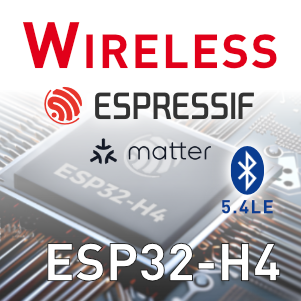
In April Espressif announced the new ESP32-H4 SoC which will extend the existing ESP32-H series. With this Espressif also will launch the first Bluetooth 5.4 enabled SoC. Current ESP BLE SoCs only supported Bluetooth 5.0 features (even if some of them where certified for up to Bluetooth 5.3)
Just like the ESP32-H2 also the ESP32-H4 will support besides Bluetooth also 802.4.15 based protocols. Another key difference is the dual-core RISC-V processor on which the H4 is built.
The ESP32-H4 is expected to deliver significant improvements in power consumption, connectivity features and memory expansion capabilities.
This new SoC is definitely aimed at the Bluetooth low energy market. This makes it very interesting for various applications not needing Wi-Fi but rather a low power Bluetooth interface.
Besides Bluetooth 5.4 with Bluetooth Mesh 1.1 the ESP32-H4 also supports IEEE 802.15.4 protocols like Thread 1.3 and Zigbee 3.0. Furthermore the ESP32-H4 is a low power SoC. This makes it the ideal solution for battery-powered Matter over Thread devices. Especially as Espressif also provides a complete development environment for Matter. Further it will be also of interest for other low-power IoT applications such as wearables, healthcare devices, LE audio devices or low power sensors.
The ESP32-H4 introduces new features such as LE Audio, LE Isochronous Channels (BIS and CIS), Connection Subrating, Periodic Advertising with Responses (PAwR) and Direction Finding using Angle of Arrival (AoA) or Angle of Departure (AoD), thus expanding the range of potential applications with Espressif SoCs. LE Audio is the latest Bluetooth audio technology enabling audio streaming via Bluetooth Low Energy (previously only via Bluetooth Classic). Bluetooth Direction Finding significantly improves the accuracy of localization compared to RSSI Positioning. PAwR makes advertising bidirectional, e.g. between a control device such as a gateway and thousands of ultra-low power nodes. This new technology is primarily aimed at retail applications such as electronic shelf labels, but also warehouse or sensor applications.
The ESP32-H4 comes with a dual-core 32-bit RISC-V processor clocked at up to 96MHz. It’s equipped with 320kB on-chip SRAM and 128kB ROM. Further it supports external Flash as well as up to 4MB PSRAM
Security
The H4 places great emphasis on affordable security features. It comes with features such as secure boot, flash encryption and various crypto accelerators to ensure the protection of private keys.
Peripherals
As you would expect from Espressif, the ESP32-H4 comes with a comprehensive range of peripherals. Besides the 35 GPIOs it integrates standard microcontroller features like I2C, I2S, SPI, UART, LED-PWM, ADC, Timers, DMA, TWAI (CAN), USB-OTG and Motor Control PWM. Special features include the Event Task Matrix for automatic-triggered task between certain peripherals (CPU independent). Additionally it comprises 14 touch sensing GPIOs, expanding HMI possibilities.
The standard development environment for the ESP32-H4 will be Espressif’s IoT Development Framework (ESP-IDF), as usual. In addition, the ESP32-H4 will also be supported in the ESP-Matter SDK in the future, which will significantly facilitate the development of Matter products.
With the Espressif will launch Bluetooth 5.4 enabled chips (and modules), aiming at low power Bluetooth applications. Espressif is also expanding its range of hardware for Matter products with this family.
You’re looking for cost effective Bluetooth and Matter solutions? Contact us for more information on Espressif’s solutions directly or send us your request here